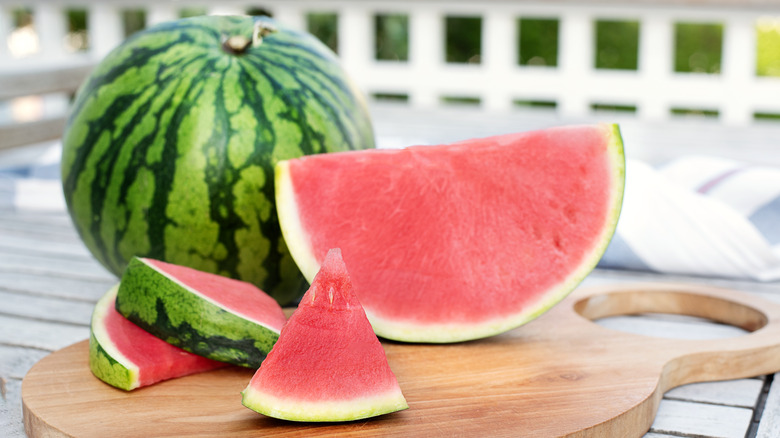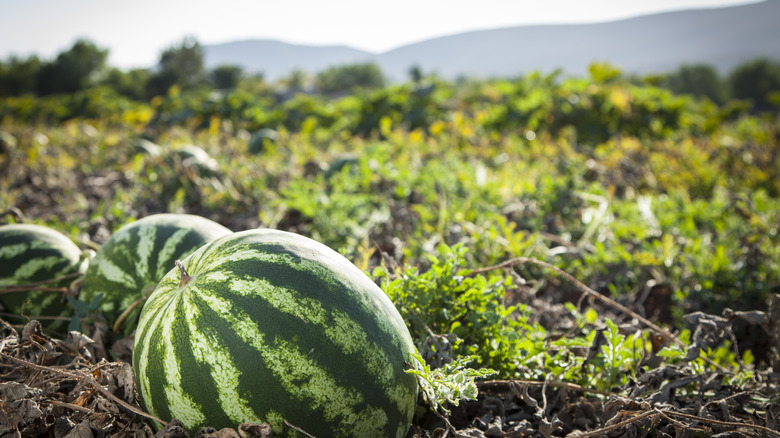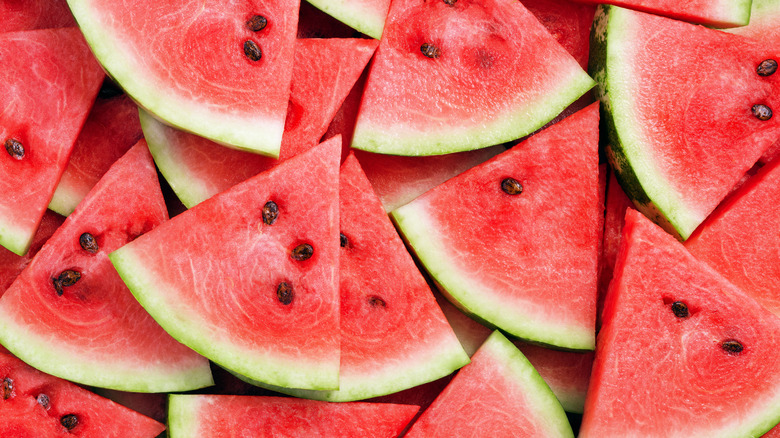Why The Term 'Seedless Watermelon' Is A Bit Misleading
The seedless watermelon may be the most quintessentially summery fruit, but seedless it is not. Crack into the striped green rind of a so-called seedless watermelon on a hot summer day in search of sweet refreshment and you're sure to find seeds speckling its pink interior. In fact, it is not the absence of seeds, but the color and texture of the seeds, that make this melon different from the others.
Picture a triangular wedge of watermelon, and you'll likely imagine a scattering of black dots. These are mature watermelon seeds, which will crunch between your teeth if consumed and will grow in the ground if planted. A cross-section of a "seedless" watermelon, on the other hand, reveals slender, soft white seeds, which are an undeveloped version of the black seeds at an earlier growth phase. These won't sprout when planted, and they're so soft that you'll barely notice them when eating watermelon.
The journey to sweet, seedless watermelon
The origins of watermelon can be traced back 5,000 years to southern Africa — though this historic melon has little in common with the fruit we love today. The first watermelon was also prized for its high water content – though another kind of fruit has an even higher percentage of water – and served as an important source of hydration for the indigenous peoples of the Kalahari Desert, but its flavor was bitter, rather than sweet.
Evidence indicates that a thousand years passed before watermelon was domesticated in northeastern Africa and sweeter melons emerged. Fast forward a few thousand more years to 1939 when Professor Hitoshi Kiara of Kyoto University in Japan developed the first seedless watermelon. Through the use of a chemical called colchicine that derives from crocus, scientists can alter the natural pollination and fertilization cycles of watermelon so that seeds never mature, remaining light in color and texture. Commercial varieties of these watermelons became available to consumers first in the United States in the 1950s.
Never fear, watermelon seeds are edible and choosing a good melon is easy
Whether you opt for seedless watermelon or not, there is no need to spit out the black or white seeds that you might encounter — they're all perfectly edible. As it turns out, the first people to eat melons enjoyed snacking on the seeds, too, and millennia later, watermelon seeds are gaining popularity in the form of seed butter. Similar to tahini in appearance and flavor, watermelon seed butter is a healthy creamy spread alternative for those with nut allergies and contains trace amounts of vitamins and minerals such as magnesium. You can make your own watermelon seed butter at home by rinsing and roasting the seeds, then pureeing them in a blender.
When you're craving this sweet summer fruit in its purest form, it can be disappointing to bite into a wedge of watermelon that is mealy or bland. There are a few tricks to picking the tastiest melon when you're at a grocery store, but as a rule of thumb, there are two things to keep in mind: time and place. Wait to enjoy watermelon during its peak season (July and August in North America) and buy from a local farm when you can!



